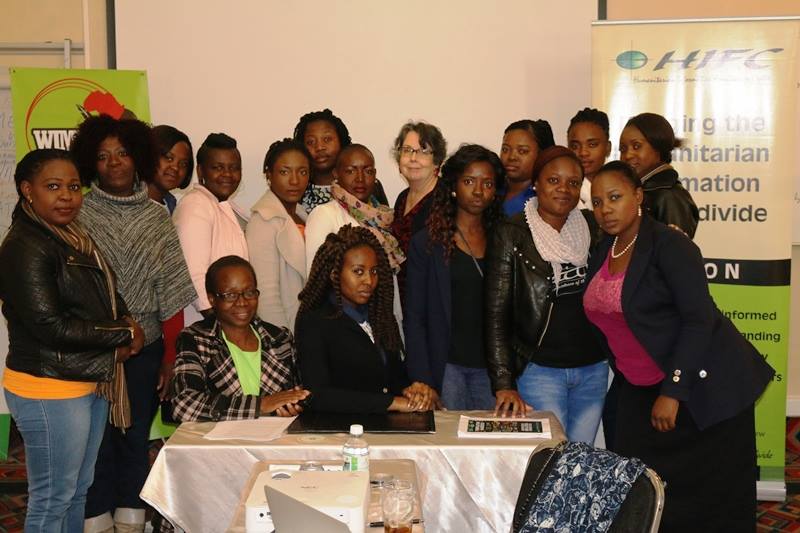Some female Zimbabwean journalists who took part in a mentorship programme jointly supported by the Humanitarian Information Facilitation Centre and the U.S Embassy. Picture credit: HIFC-U.S Embassy
By Sibongile Mpofu
Zimbabwe’s media classes are dominated by women, but the work space has more men. What is the story, and what are the issues at play?
The battle for gender equity in newsrooms around the globe is a long and contentious one. This phenomenon is not peculiar to the media sector, but a symptomatic problem in wider society where women have generally been excluded from the workplace or rather continue to make up less of the labour force compared to men.
What makes the media industry particularly unique is that journalism and media training institutions churn out more female graduates than male – in what some scholars term ‘feminisation of journalism’ – and yet this has not translated to gender parity in the labour force within the media sector.
Empirical research has found that men continue to dominate in news production in all forms of media, despite the high numbers of female graduates. Earlier research by Margaret Gallagher, for example, shows that in 1995, women accounted for at least 50 percent of journalism and mass communication students in the 83 countries that were surveyed, including Zimbabwe. This figure has been steadily rising since then.
Women dominant in school
In the Southern African Development Community region, latest figures by the Gender Barometer 2018, indicate that female students make up 60 percent of enrolment in journalism and media studies training across the majority of the countries – in stark contrast to the proportion of women in media.
In Zimbabwe, for example, of the 216 journalism graduates at the National University of Science and Technology, between 2015 and 2018, 135 of these are females, which translates to 62.5 percent. The situation is similar to that obtaining at the Midlands State University where females enrolling for media training are more than males.
While exact figures could not be obtained, sources within the institutions revealed that in most courses, the ratio of females to males is 4:1. Similarly in the United Kingdom, the number of women studying journalism out number that of men. So, generally, there has been a steady rise in the number of women accessing higher education, which is something to celebrate – but with caution.
The fact that women are accessing higher education is good – the problem then arises when it comes to the labour market. Therefore, the rising numbers of female graduates does not correlate to employment levels, as alluded to above. Studies have found that the marginal numbers of females working in the media are found in the lower and middle levels globally, the top positions including those of: publishers, editors, producers, and executives are still male dominated.
What is the missing link?
Clearly, there is a missing link that needs to be addressed. The bone of contention though for media scholars and activists has been that this positive trend in gender equality for women in higher education, particularly journalism education needs to be enforced in the labour market.
Questions continue to be posed as to why females dominate journalism education yet newsrooms continue to be dominated by men. What is clear is that overarching economic and socio-cultural factors continue to reverse the gains attained for gender equality in higher education as long as women continue to be invisible in key positions in the labour force, and specifically in the media sector.
The Zimbabwe story
In the case of Zimbabwe, the fact that there are fewer women than men in the newsrooms in general, and in senior positions specifically, attests to the underlying problems in our society that still marginalise and restrict women to certain work spaces and positions, and not others.
The gender-insensitive media environment force out or deter women to enter newsrooms and hence opt for other career choices. Lack of gender policies in media houses, for example, result in employers preferring men over women. Cultural impediments such as women travelling away from home and working in the evenings also stand as a barrier for employment of female journalists.
“Softer programme”
Therefore, Journalism, while at tertiary level is viewed as a ‘softer’ programme resulting in more females opting for it, different set of rules manifest when it comes to the labour market. It is quite glaring that power sets the rules for the game.
Gender discrimination comes into play because all of a sudden, patriarchy reminds us that the media – because of its powerful role in society as the Fourth/Fifth Estate, cannot be led by women. Therefore, the playing field is not level.
Masculine culture
The masculine culture manifests more in the job market because this is the arena which separates and buttresses power positions between men and women. For example, according to the Gender Barometer 2018, of the 1 266 employees in four key media organisations in Zimbabwe, men held 933 of those compared to 353 for women.
In the United States, Women’s Media Centre Report 2017, reveal that men still receive 62 percent of by-lines and other credits in print, online, television and wire services. Therefore, women are deterred from entering the newsroom due to varying factors, some of which have been empirically tested.
Correction strategies
To level the playing field, some of the strategies that could be employed are the implementation of gender policies in media houses, to institutionalise gender equality and equity. There is also a need for establishing close working relationships between media houses and media training institutions to support the former in the implementation and monitoring of gender equality and equity.
In addition, more research on the contribution of male and female journalists to the media fraternity is needed so to inform employment policies. I believe these strategies among others, could assist in transforming societal views on the need to give equal opportunities to men and women.
*Figures from NUST are for the undergraduate programme only.
Dr. Sibongile Mpofu is a lecturer in the Department of Journalism and Media Studies at the National University of Science and Technology.
Do you want to use our content? Click Here












